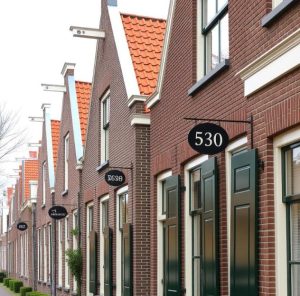 Every street in the Netherlands tells a story through its details, and one of the smallest yet most personal elements is the humble house sign. From Delft’s blue ceramic tiles to sleek steel plates in Amsterdam, these custom house numbers are more than just functional markers. They are subtle reflections of local culture, family pride, and neighborhood character. Each one designed to say something about the people who live behind the door.
Every street in the Netherlands tells a story through its details, and one of the smallest yet most personal elements is the humble house sign. From Delft’s blue ceramic tiles to sleek steel plates in Amsterdam, these custom house numbers are more than just functional markers. They are subtle reflections of local culture, family pride, and neighborhood character. Each one designed to say something about the people who live behind the door.
Across Dutch towns, the rise of personalized home décor has made it easier for homeowners to express individuality even through their front doors. Many now order a house number sign online (source: huisnummerbordje online bestellen) to match their home’s architecture, using creative designs that blend tradition with modern design trends. These small signs have quietly become a part of the Netherlands’ visual language, regularly featured in lifestyle magazines and design columns for their charm and artistry.
The Design Language of Dutch Streets
Walking through a Dutch neighborhood feels like stepping into an open-air gallery of typography and design. The diversity of house signs reflects the country’s broader love for craftsmanship and minimalism. Some prefer classic enamel numbers reminiscent of the 1920s, while others opt for laser-cut stainless steel for a more contemporary feel. Each piece contributes to a street’s visual rhythm, creating harmony between architecture, color, and materials.
Local design journalists often highlight these elements when covering Dutch living trends. Publications have noted how house signs mirror the balance between personal taste and community identity, a key theme in Dutch lifestyle reporting. It’s common to see photo essays focusing on the beauty of these everyday items, capturing how they change from city to city.
From Craftsmanship to Customization
The Dutch take pride in their tradition of craftsmanship, and that extends to how their homes are marked. Custom signs are often handmade by local artisans who work with materials such as ceramic, slate, and brass. The personalization process allows residents to choose fonts, colors, and motifs that align with their home’s story. Whether inspired by a farmhouse heritage or a modern design ethos, each choice reflects cultural roots.
- Material choice: Ceramic and enamel remain popular for their durability and vintage charm.
- Typography: Many signs feature distinctive Dutch typefaces or clean sans-serif fonts associated with modern design.
- Symbolism: Some families incorporate windmill motifs or tulips, tying back to national symbols.
This personalization goes beyond aesthetics, it’s also a nod to identity and belonging. For small towns and villages, the designs often carry regional influences. A sign in Friesland might showcase traditional blue-and-white palettes, while one in Limburg could use warmer tones reflecting the southern spirit.
House Signs in Local Journalism and Culture
Over the past few years, Dutch lifestyle journalists have begun treating house signs as cultural artifacts. They are often featured in weekend supplements that explore how people define “home” in a fast-changing society. From Rotterdam to Utrecht, photo essays and design reports celebrate how these little plaques tell big stories about taste, heritage, and modern identity. You can read more about how local journalism shapes cultural trends through design and lifestyle storytelling in Unlocking the Power of Media and Press.
Local councils and historical societies have also embraced the trend. Some municipalities even encourage residents to use designs that reflect neighborhood history. This practice transforms ordinary signage into storytelling tools, connecting people to the architectural legacy around them.
Digital Convenience Meets Local Character
While craftsmanship remains at the heart of Dutch design, digital platforms have expanded access to customization. Today, homeowners can easily find artisans or digital workshops offering personalized options and order a house number sign online from the comfort of their homes. This blend of digital convenience and local artistry shows how traditional aesthetics continue to evolve alongside technology.
Online stores now act as modern marketplaces for old traditions. They make it possible for anyone, from a young family in Utrecht to a retiree in Groningen, to design something unique without leaving their home. This shift has helped preserve the tradition of house signs while making it relevant to the digital age.
Why It Matters
Custom house signs may seem like a small detail, but they tell powerful stories about community, identity, and heritage. They represent the meeting point of design, craftsmanship, and cultural pride. By embracing personalization, Dutch homeowners are not only beautifying their spaces but also continuing a long-standing tradition of self-expression through design.
From local artisans to digital platforms, the Dutch approach to customization bridges the past and the present. The act of choosing, crafting, and displaying a personalized plaque embodies what makes Dutch culture unique is its respect for detail, love for design, and commitment to individuality. Whether through a handcrafted ceramic tile or a modern steel plate, every home quietly communicates its story to the world. And for those looking to join this meaningful tradition, it’s easier than ever to order a house number sign online and make their mark on their community’s visual landscape.
